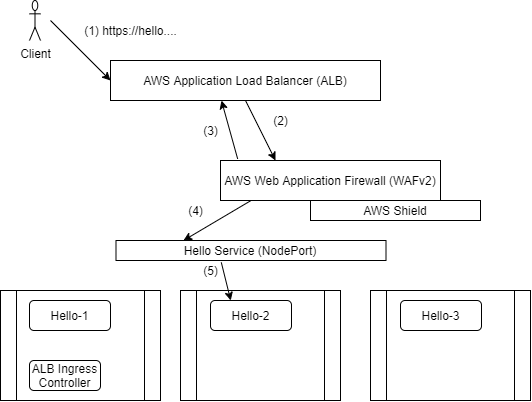AWS ALB
This content is authored by Red Hat experts, but has not yet been tested on every supported configuration.
Note: It is recommended that you use the Cloud Front based guide unless you absolutely must use an ALB based solution.
Here ’s a good overview of AWS LB types and what they support
Problem Statement
Operator requires WAF (Web Application Firewall) in front of their workloads running on OpenShift (ROSA)
Operator does not want WAF running on OpenShift to ensure that OCP resources do not experience Denial of Service through handling the WAF
Proposed Solution
Loosely based off EKS instructions here - https://aws.amazon.com/premiumsupport/knowledge-center/eks-alb-ingress-aws-waf/
Deploy secondary Ingress solution (+TLS +DNS) that uses an AWS ALB
- Todo Configure TLS + DNS for that Ingress (Lets Encrypt + WildCard DNS)

Pre Requisites
- A ROSA / OSD on AWS cluster
- Helm 3 cli
- oc / kubectl
- AWS cli
Disable AWS cli output paging
export AWS_PAGER=""Set the ALB Controller version
export ALB_VERSION="v2.2.0"Set the name of your cluster for lookup
export CLUSTER_NAME="waf-demo"
Deployment
Create a new public ROSA cluster called waf-demo and make sure to set it to be multi-AZ enabled, or replace the cluster name variable with your own cluster name.
AWS Load Balancer Controller
AWS Load Balancer controller manages the following AWS resources
Application Load Balancers to satisfy Kubernetes ingress objects Network Load Balancers in IP mode to satisfy Kubernetes service objects of type LoadBalancer with NLB IP mode annotation
Create AWS Policy and Service Account
curl -so iam-policy.json https://raw.githubusercontent.com/kubernetes-sigs/aws-load-balancer-controller/${ALB_VERSION}/docs/install/iam_policy.json POLICY_ARN=$(aws iam create-policy --policy-name "AWSLoadBalancerControllerIAMPolicy" --policy-document file://iam-policy.json --query Policy.Arn --output text) echo $POLICY_ARNCreate service account
aws iam create-user --user-name aws-lb-controller \ --query User.Arn --output textAttach policy to user
aws iam attach-user-policy --user-name aws-lb-controller \ --policy-arn ${POLICY_ARN}Create access key and save the output (Paste the
AccessKeyIdandSecretAccessKeyintovalues.yaml)aws iam create-access-key --user-name aws-lb-controllerexport AWS_ID=<from above> export AWS_KEY=<from above>Modify the VPC ID and cluster name in the
values.yamlwith the output from (replacepoc-wafwith your cluster name):VPC_ID=$(aws ec2 describe-vpcs --output json --filters \ Name=tag-value,Values="${CLUSTER_NAME}*" \ --query "Vpcs[].VpcId" --output text) echo ${VPC_ID}Modify the subnet list in
ingress.yamlwith the output from: (replacepoc-wafwith your cluster name)SUBNET_IDS=$(aws ec2 describe-subnets --output json \ --filters Name=tag-value,Values="${CLUSTER_NAME}-*public*" \ --query "Subnets[].SubnetId" --output text | sed 's/\t/ /g') echo ${SUBNET_IDS}Add tags to those subnets (change the subnet ids in the resources line)
aws ec2 create-tags \ --resources $(echo ${SUBNET_IDS}) \ --tags Key=kubernetes.io/role/elb,Value= Key=kubernetes.io/cluster/${CLUSTER_NAME},Value=sharedCreate a namespace for the controller
kubectl create ns aws-load-balancer-controllerApply CRDs
kubectl apply -k "github.com/aws/eks-charts/stable/aws-load-balancer-controller//crds?ref=master"Add the helm repo and install the controller (install helm3 if not already)
helm repo add eks https://aws.github.io/eks-charts helm install -n aws-load-balancer-controller \ aws-load-balancer-controller eks/aws-load-balancer-controller \ --set "env.AWS_ACCESS_KEY_ID=${AWS_ID}" \ --set "env.AWS_SECRET_ACCESS_KEY=${AWS_KEY}" \ --set "vpcID=${VPC_ID}" \ --set "clusterName=${CLUSTER_NAME}" \ --set "image.tag=${ALB_VERSION}" \ --create-namespace
Deploy Sample Application
Create a new application in OpenShift
oc new-project demo oc new-app https://github.com/sclorg/django-ex.git kubectl -n demo patch service django-ex -p '{"spec":{"type":"NodePort"}}'Create an Ingress to trigger an ALB
cat << EOF | kubectl apply -f - apiVersion: networking.k8s.io/v1 kind: Ingress metadata: name: django-ex namespace: demo annotations: kubernetes.io/ingress.class: alb alb.ingress.kubernetes.io/scheme: internet-facing alb.ingress.kubernetes.io/target-type: instance # alb.ingress.kubernetes.io/subnets: subnet-0982bb73ca67d61de,subnet-0aa9967e8767d792f,subnet-0fd57669a80eb7596 alb.ingress.kubernetes.io/shield-advanced-protection: "true" # wafv2 arn to use # alb.ingress.kubernetes.io/wafv2-acl-arn: arn:aws:wafv2:us-east-2:660250927410:regional/webacl/waf-demo/6565d2a1-6d26-4b6b-b56f-1e996c7e9e8f labels: app: django-ex spec: rules: - host: foo.bar http: paths: - pathType: Prefix path: /* backend: service: name: django-ex port: number: 8080Check the logs of the ALB controller
kubectl logs -f deployment/aws-load-balancer-controlleruse the second address from the ingress to browse to the app
kubectl -n demo get ingresscurl -s --header "Host: foo.bar" k8s-demo-djangoex-49f31c1921-782305710.us-east-2.elb.amazonaws.com | head
WAF time
Create a WAF rule here https://console.aws.amazon.com/wafv2/homev2/web-acls/new and use the Core and SQL Injection rules. (make sure region matches us-east-2)
View your WAF
aws wafv2 list-web-acls --scope REGIONAL --region us-east-2 | jq .set the waf annotation to match the ARN provided above (and uncomment it) then re-apply the ingress
kubectl apply -f ingress.yamltest the app still works
curl -s --header "Host: foo.bar" --location "k8s-demo-djangoex-49f31c1921-782305710.us-east-2.elb.amazonaws.com"test the WAF denies a bad request
You should get a 403 Forbidden error
curl -X POST http://k8s-demo-djangoex-49f31c1921-782305710.us-east-2.elb.amazonaws.com -F "user='<script><alert>Hello></alert></script>'"
